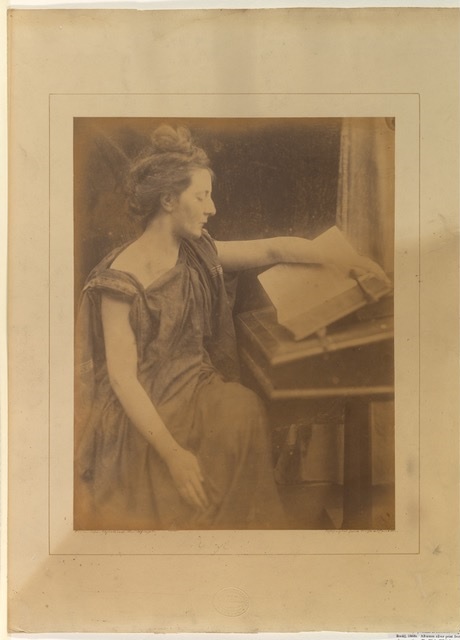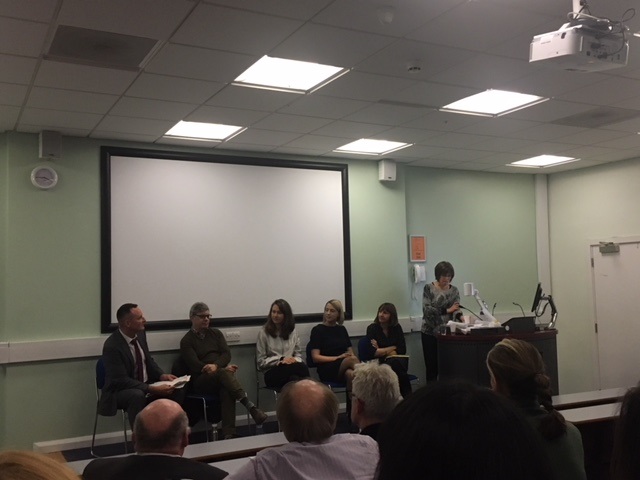Maria Alambritis, PhD candidate in History of Art, discusses a panel examining the current state and future of publishing art historical scholarship – one of a series of events celebrating the 50th anniversary of the Birkbeck’s Department of History of Art.

Woman in Robes Reading a Book, 1870, Albumen silver print from glass negative, Metropolitan Museum of Art, New York (69.607.11)
On Friday 19 October, Birkbeck’s History of Art department hosted ‘Forward Looking: Workshops on the Future of Art History’, part of a series of events held this year to mark the 50th anniversary of the department’s founding. The second workshop of the day – ‘Futures for Publishing in Art History’ – examined the state of publishing art historical scholarship as it now stands and addressed current areas of concern and innovation.
Chaired by Dr Leslie Topp, Head of Birkbeck’s History of Art department, the session was structured as a series of ‘in-conversations’ between Leslie and each of the invited participants, who each brought to bear their individual experience and expertise in relation to art historical publication. The panel included Natalie Foster, Senior Publisher for Media and Cultural Studies at Routledge; Baillie Card, Editor at the Paul Mellon Centre; Bernard Horrocks, Intellectual Property Manager at Tate; and Steve Edwards, professor of History and Theory of Photography at Birkbeck and Editorial Board Member at the Oxford Art Journal.
Four key interlocking themes arose across the individual discussions: the ongoing relevance of print publication in the wake of new digital formats; the nature and impact of open access scholarship; the influence of the UK’s Research Excellence Framework (REF) and the complexity of copyright law and issue of image reproduction fees.
Print vs. digital publishing
Natalie Foster illuminated the ways Routledge, which has emerged in recent years as a leading publisher in art historical scholarship, approaches the publication of scholarly monographs, discussing aspects of format, style and topic. Together with an existing focus on areas such as media, film and visual studies, historiography, museology and collecting, Routledge is looking to include design history, photography theory and ‘cutting-edge’ titles in areas such as gender, non-Western art and the Anthropocene. One of the principal areas of uncertainty for both academics and publishers today is the continuing role of print publications in the wake of new digital formats and online open-access models. It was interesting to hear that despite this ‘digital turn’ in publishing, Routledge did not consider print and digital formats as mutually exclusive, acknowledging the on-going relevance of the printed monograph format particularly for academics at the start of their careers.
In her role overseeing the publication of the Paul Mellon Centre’s ground-breaking open access journal British Art Studies, Baillie Card spoke about the differences in approach and challenges encountered in publishing and editing online as opposed to print. The advantages of online publication, especially in offering new possibilities for the kind of scholarship produced and innovative means of presenting research such as utilising video, audio and infographics were demonstrated with examples such as Inga Fraser’s video essay on the work of Paul Nash.
Card described the exciting potential inherent in online presentation as a more ‘curatorial way of arguing’ in contrast to that seen in traditional print journals. Juxtaposing multiple images and offering interpretation in a range of formats, the ‘author-curator’ employs enhanced digital features to enable a greater freedom in the style of argument and inviting simultaneous response, interpretation and discussion.
Open access
However, the exciting potential offered by open access is not without its drawbacks. In the example of British Art Studies, the Paul Mellon Centre has a measure of financial freedom allowing it to take risks and experiment with scholarship in this way. Card cited several ‘open-access ways’ available to others interested in exploring the possibility of setting up their own online journal spaces, such as the Getty’s ‘Quire’– a freely accessible multiformat publishing tool to create lasting, discoverable scholarly publications online.
Steve Edwards acknowledged that open-access has many advantages in terms of widening access to research and presenting scholarship in innovative ways, but pertinently noted that the model nevertheless entails the shuffling of public money to the private sector, an on-going and debilitating part of a wider problem across the public education sector.

REF
The Research Excellence Framework (REF) is a process of assessment which reviews the research outputs of the UK’s publicly-funded research institutions. It judges the quality of the outputs, their impact beyond academia and the environment (facilities and resources) that supports research in each university faculty department.
It was encouraging to hear that despite the REF’s hierarchisation of individually-authored monographs over edited collections, Routledge did not follow suit, acknowledging the importance of such collections for bringing together new voices, particularly from a global angle. Publishing in open access journals such British Art Studies poses concerns for scholars where the framework of the REF or, in a similar case, the American tenure-track system does not currently accommodate such formats as ‘legitimate’ forms of published scholarship. As highlighted by Steve Edwards, rather than a passive monitoring system, the REF is actively shaping the future of art history publishing, as future funding is allocated according to REF score. This has wide-ranging implications, as universities shape their research to target REF requirements, rather than producing research for its own inherent scholarly merit and usefulness to the field. The pressure to produce ‘REF-able’ publications works against the establishment of new, interdisciplinary journals for which the REF’s rigid criteria has no means of assessing, thereby entrenching disciplinary boundaries.
Copyright law, image reproduction fees and ‘fair dealing’
A discussion of online art history publishing cannot avoid the complex issue of image rights. The use of fair dealing and its potential to aid scholars was explored in depth. Baillie affirmed that British Art Studies tries wherever possible to use images under the principle of fair dealing. As detailed here (scroll down for the section on ‘Art History and Fair Dealing’), fair dealing allows the reproduction of copyrighted works without the requirement to pay a fee, so long as the cited work is being used in a ‘fair’, non-commercial way, such as illustrating a passage of criticism or review.
Bernard Horrocks expanded on this discussion looking at the intersection of law, museums, publishing and copyright. The current issue of whether public arts institutions should make images of their collections freely accessible was the subject of lively debate. Tate offers low-resolution images of out-of-copyright works for free, while high-quality images must be paid for. Horrocks stated that Tate makes on average £200,000 a year from image rights fees, acknowledging that while not a huge amount in the overall scheme of the museum’s annual profits it is nonetheless indispensable in today’s increasingly difficult climate arts funding cuts. As raised in the later roundtable discussion, however, it is not clear how much of this sum actually comes from non-commercial scholarly requests.
While the ranks of foreign museums releasing their collection images for free continues to grow – examples include the Rijksmuseum Amsterdam and the Metropolitan Museum of Art in New York – Horrocks argued that these institutions operate on different governance and funding models, the prime example being the charging of entrance fees. However, an interesting alternative UK precedent has been set by Birmingham Museums Trust, which recently made high-quality images of out-of-copyright works in its collection freely accessible.
As with the REF, image copyright itself is shaping research often in very direct ways. Citing the example of his own publications, Edwards has turned to using images freely available from US collections, over examples from UK institutions. Furthermore, the lack of uniformity across UK institutions as to what constitutes a ‘non-commercial’ and ‘scholarly’ publication combined with the fact that liability still rests in the majority of cases with the individual author, rather than the publisher, continues to make image reproduction an increasingly murky and difficult area for scholarship and one that is particularly egregious for art historians.
Following these ‘in-conversations’ a roundtable was held with all the participants and joined by Stacey McGillicuddy, Publisher for Taylor & Francis art journals. It became clear that greater communication between academics and image rights departments would enable a far more efficient and scholarship-friendly means of determining non-commercial use, which as it is currently defined by many picture library departments is out of date and inconsistent with the existing nature of scholarly publication. Finally, in the move towards publishing online, the issue of longevity was raised and the development of digital preservation policies as we move from physical material to digital publications.
The workshop was one of transparent and open debate, which highlighted the advantages that such an interdisciplinary and collaborative debate brings, particularly at a moment of rapid change in art historical publishing.
Both workshops were kindly supported by the Murray Bequest.